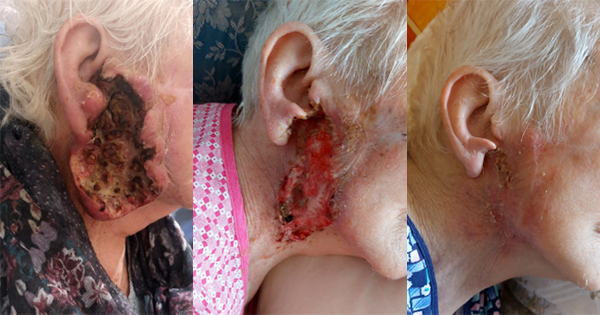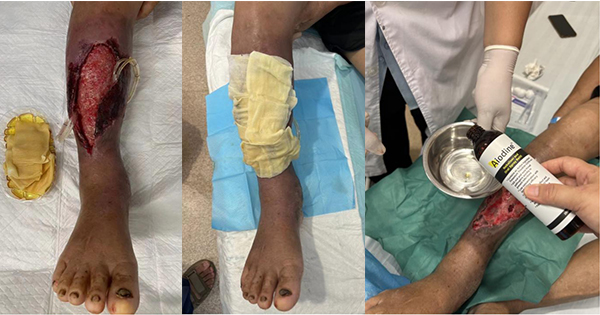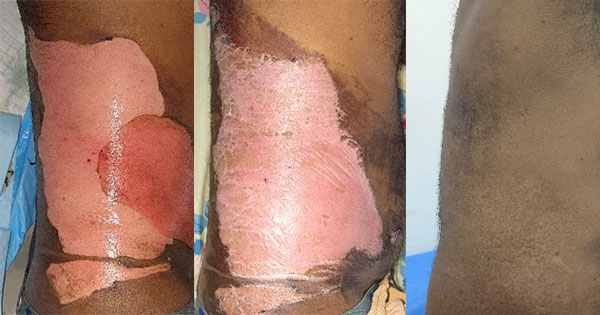According to the GLOBOCAN estimates from 2020, head and neck squamous cell carcinoma (HNSCC) is the seventh most common cancer globally, with an estimated 890,000 new cases, around 4.5% of all cancer diagnoses around the world, and 450,000 deaths per year, approximately 4.6% of global cancer deaths (Sung et al, 2020). It is understandable that HNSCC causes a negative impact on the quality of life of these individuals and their family, including significant psychological distress and substantial functional impairments (Adamowicz et al, 2022). These malignant growths often present with a fungating and ulcerative appearance and are frequently accompanied by excoriation of the surrounding skin, intense malodour, profuse fibrinous or purulent exudate, bleeding and pain (O’Neil et al, 2022).
Unfortunately, tumours that breach the skin and create a malignant fungating wound, are sometimes confused for an infection or abscess, and are thus managed prophylactically with systemic antibiotics at initial presentation instead of referring the individual to the head and neck oncologic team (O’Neill et al, 2022). It is suggested that any neck mass should be considered malignant until proven otherwise (Tan and Jaya, 2020).
Malignant wounds have a significant adverse effect on the health-related quality of life of patients, with significant physical symptoms including pain, exudate, malodour, bleeding and infection (Chen et al, 2024). Furthermore, psychosocial symptoms of malignant wounds include depression, embarrassment, shame, guilt, stigmatisation, and worthlessness, which can exacerbate negative QoL (Ousey et al, 2024).
Furka et al (2020) state that the most important component of cancerous wound care is to select the appropriate wound dressing. Antimicrobial dressings are considered beneficial due to accompanying infection and, moreover, the antimicrobial properties of silver dressings are very effective to reduce malignant fungating wound discharge and malodour (Tsichlakidou et al, 2019).
Technology lipido colloid with silver
Technology lipido colloid mesh with silver dressings (TLC-Ag dressings, UrgoTul Ag® – Laboratoires Urgo, France,) are supported by both in vitro and in vivo evidence (Lazareth et al 2007; 2008; 2012; Bison et al, 2013; Desroche et al 2016). The lipido-colloid particles gellifies in contact with wound exudate, maintaining a moist environment favourable to the promotion of wound healing (White et al, 2015), while the Ag+ ions provide anti-inflammatory properties and antimicrobial activity, leading to reduction of the microbial load (Bison et al, 2013; Desroche et al 2016).
The efficacy of TLC-Ag in reducing clinical signs of local infection and promoting wound healing, has been demonstrated in a randomised controlled trial (Lazareth, 2012). Moreover, in a large observational study from Germany, 728 patients with wounds of various aetiologies and wound infection status were treated with the TLC-Ag dressings in 39 centres for 4 weeks (Lützkendorf et al, 2022). At the initial visit, 60.4% of patients had an established wound infection, while the remaining presented some clinical signs of a local infection (25.1%) or were at risk of wound infection (13.2%). Throughout the study period, all the parameters of wound infection continuously decreased with a reduction by 78.9% of the prevalence of local wound infections and by 72.0% of the clinical signs of wound infection, which included a reduction in exudate levels, malodour and pain. By the final visit, 92.1% of wounds either healed or improved.
Based on the good performance of the dressing in the management of clinical signs of infection, the authors decided to assess the TLC-Ag dressing in the specific indication of post-excision carcinoma wound.
The cases
Case 1: Dr. Stefano Ghislanzoni, Wound Care Specialist Nurse at the Istituti Clinici Zucchi e ADI (Assistenza Domiciliare Integrata, Integrated Home Care, Vivisol) Service, in Milan, Italy, reported the case of a 92-year-old female with past medical history of arterial hypertension, type 2 diabetes mellitus, osteoarthritis and hypercholesterolemia. This patient underwent surgical excision and radiotherapy in June 2023 for infiltrating ulcerated squamous cell carcinoma on the right cheekbone. Subsequently, she developed a recurrence with a neoplasm in the neck and the lateral cervical area, extending to the periauricular level, in the already irradiated tissues, for which an immunotherapy treatment was initiated. In May 2024, she was taken over by the ADI service. On referral, the patient presented with an ulcerated lesion with an irregular base, thickened, irregular edges and margins, necrotic areas, and abundant foul-smelling exudate [Figure 1A]. The pain was scored at 6/10 with a Pain Numeric Rating Scale (PNRS) (Nugent et al, 2021). For about 3 weeks, the lesion was treated with a silver calcium alginate dressing, without significant benefit, with persistent pain and suboptimal management of the exudate.
Afterward, a treatment with the TLC-Ag dressing was implemented and changed three times a week, using sterile gauzes as a secondary dressing, while the wound bed was cleansed with 0.9% saline solution to remove exudate and moisture, and mechanical debridement was performed with sterile gauze. By 01/07/2024 (5 weeks later) the wound bed showed great improvement with a significant reduction in exudate levels, foul odour and pain (PNRS Score 2/10) [Figure 1B]. Wound healing continued to improve [Figure 1C], with complete wound closure recorded on 04/09/2024 [Figure 1D].
The wound was a detriment to the patient’s quality of life, including isolation due pain and embarrassment from the appearance, exudate, and malodour. The progression of the wound allowed this individual to return to her normal life regarding her physical health, cognitive-emotional wellbeing, and social engagement.
Case 2: Dr. Rajaa Dellak and Joanna Rogowska are nurses at Cum Sortis, a Palliative Home Care Unit providing home nursing services for patients with various needs, including dressing changes, management of medical devices such as bladder catheters, ostomies, and nasogastric tubes, as well as care of terminal patients by means of a multidisciplinary team.
They reported the case of an 87-year-old male with a history of, hypertension, diabetes mellitus type 2, hepatitis B, kidney stones, and a locally advanced squamous cell tumour with extensive skin ulceration and bleeding, infiltrating paravertebral tissue and left parotid gland. The patient was initiated with chemotherapy in July 2024 and immunotherapy in September of the same year for ulceration reduction. Severe pain was reported by the patient (8/10 PNRS score) which was treated with oral opioid medications.
The cancerous ulceration presented with a fibrinous, irregular wound bed and minimal necrotic margins. The wound was previously managed in hospital, with saline solution rinse, povidone iodine and greasy gauze dressings, without positive evolution [Figure 2A]. From July onwards, the wound was managed by the Home Care Services. The wound was cleansed with saline and soaked with a local chlorine antiseptic. The TLC-Ag contact layer was selected as the primary dressing and covered with an absorbent secondary dressing, with daily dressing changes due to abundant exudate. After 8 weeks of treatment, as exudate levels were reducing, the dressing was changed on alternate days. The wound was completely healed by the beginning of December.
As in the previous case, resolution of this ulcer helped the patient to return to his normal life without pain and isolation. Exudative, malodorous wounds are oppressive and restrictive, with regard to not only physical and psychological but also social wellbeing (Klein et al, 2020).
Discussion
In these two challenging cases, implementation of the TLC-Ag dressing as a primary dressing resulted in a series of clinical improvements. The gelling property of the TLC-Ag matrix contributed to the maintenance of a moist environment conducive to healing, its antimicrobial properties resulted in a reduction of the local clinical signs and symptoms of infection, while the open weave of the dressing allowed for optimal management of exudate with appropriate secondary dressings. The non-adherent dressing also substantially reduced the painful symptoms associated with the wound and dressing changes, improving the patient’s comfort.
The clinicians opted to use this antimicrobial dressing for extended periods to fight the ongoing clinical signs and symptoms of local infection and to avoid re-infection. Cancer-related wounds often become infected, as many malignant wounds provide ideal conditions for secondary infection to develop, due to high exudate levels, the presence of non-viable tissue, and some difficult-to-treat anatomical locations (Ousey et al, 2024)
Conclusion
The management of squamous cell carcinomas, in general, involves the use of multiple strategies, such as surgery, systemic anti-cancer therapy, immunotherapy and radiotherapy, alone, in combination, or sequentially (Saini and Twelves, 2021). When standard excision is performed for high-risk tumours, a linear repair, skin graft or healing by second intention is recommended (Alam et al, 2018). In wounds healing by second intention, the main goals of the management plan should focus on optimizing the patient’s general condition, infection control, cleaning of the wound, debridement of any necrotic tissues (where indicated), and malodour and pain management (Labib and Winters, 2023).
In the presented cases of elderly patients with ulcerated tumour lesions and multiple comorbidities, the use of the TLC-Ag dressings offered substantial benefits. These experiences have shown that the TLC-Ag dressings can significantly improve local infection signs and symptoms, avoid secondary wound infection, avoid procedural pain due to the non-adherent properties, while also promoting healing.
These results highlight the importance of personalized management of ulcerative lesions, aimed at improving the quality of life of patients through innovative and effective therapeutic approaches. Although this article portrays and discusses only two cases, it is ascertained, based on the evidence-base of the dressings and clinician experience, that the use of the TLC-Ag dressings can, as part of the patients’ holistic management, improve patient wound care outcomes.





